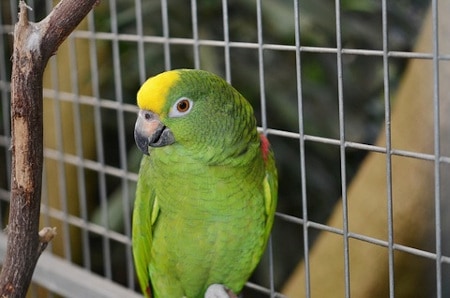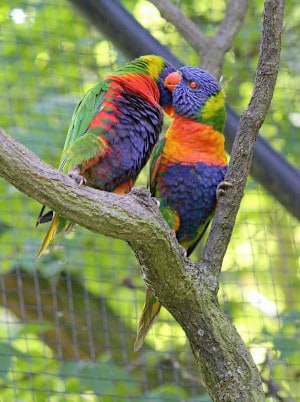There is a lot of debate surrounding the topic of whether or not parrots can be kept outside.
Some people say that it is cruel to keep them cooped up in cages, while others argue that they need to be inside for their safety.
In this blog post, we will explore both sides of the argument and let you decide what is best for your pet parrot.
What are the benefits of keeping your parrot outdoor?
Parrots are social creatures that enjoy interacting with their human companions.
However, they also need time to explore and play in their natural environment.
When kept outdoors, parrots can enjoy the fresh air and sunshine while getting the exercise they need to stay healthy.
Additionally, outdoor parrots have the opportunity to socialize with other birds, which can help reduce boredom and stress.
There are a few things to keep in mind when keeping your parrot outdoors, such as providing a safe enclosure and ensuring that the temperature does not get too hot or cold.
However, overall, the benefits of letting your parrot enjoy the great outdoors far outweigh any potential risks.
You may also like: Do Budgies Need Sunlight?
What are the risks of keeping your parrot outside?

For many people, their backyard is a little slice of paradise – a place to relax, enjoy the fresh air, and watch the birds play.
However, if you have a pet parrot, you may be wondering if it’s safe to keep them outdoors.
There are certain risks associated with keeping your parrot outside.
The most important thing is to weigh the risks and benefits carefully before making a decision.
Risk of predators
One of the biggest risks of keeping your parrot outside is the risk of predators.
If you live in an area with foxes, coyotes, or other predators, it’s simply not safe to leave your parrot unattended.
Even large birds of prey can pose a threat, so it’s important to make sure your parrot has a safe place to perch out of reach.
Risk of extreme weather conditions
Additionally, extreme weather conditions can also be dangerous for parrots. If it’s too hot or too cold, your parrot could become sick or even die.
As a result, it’s important to monitor the weather closely and bring your parrot inside at the first sign of trouble.
Risk of pathogens
There are a few risks to keeping your parrot outside, the most important being exposure to pathogens.
Pathogens are everywhere in the environment and can cause serious illness or even death in parrots.
Some of the more common pathogenic organisms include bacteria, viruses, fungi, and parasites.
It is important that you take measures to reduce the risk of pathogen exposure to your parrot.
You may also like: 7 Common Budgie Sleeping Positions and Their Meanings
Can parrots be kept outside?
Parrots are very social animals, and they need a lot of attention from their owners. For this reason, many parrot experts recommend against keeping them outside.
While parrots can technically survive in outdoor enclosures, they are much more likely to thrive when kept indoors.
Outdoor parrots are more likely to expose the risk to predators, and they may also be subject to harsh weather conditions.
In addition, outdoor parrots are more likely to come into contact with other birds, which can lead to the spread of disease.
As a result, it is generally best to keep parrots inside the home, where they can receive the care and attention they need.
There are certain risks associated with keeping your parrot outside, but there are also some benefits.
The most important thing is to weigh the risks and benefits carefully before making a decision.
What temperature should parrots be kept in?
The optimal temperature for parrots is between 65 and 80 degrees Fahrenheit (18 to 27 degrees Celsius).
Any colder than that and the bird could become uncomfortable and stressed, any hotter and it could lead to dehydration and heatstroke.
Parrots originate from tropical climates and are used to much higher temperatures than most other pet birds.
As long as the ambient temperature isn’t too hot or cold, your parrot will be perfectly fine at these temperatures.
What temperature is too cold for parrots?
Parrots are tropical birds, and as such, they prefer warm climates.
In fact, most parrots can only tolerate temperatures that are above 65 degrees Fahrenheit (18 degrees Celsius).
However, there are a few hardy species that can withstand cooler conditions.
If the temperature drops below 60 degrees Fahrenheit (15 degrees Celsius), however, your parrot is likely to become ill.
If you live in an area with cold winters, it is best to provide your parrot with a heated birdcage or indoor aviary.
By taking these precautions, you can help ensure that your parrot stays healthy and happy all year round.
You may also like: Why Is My Budgie Sleeping So Much? Should I Be Worried
How do I know if my parrot is feeling cold?
Parrots are sensitive to changes in temperature.
If your parrot is huddled in the corner of the cage, fluffed up, and visibly shivering, then it is probably cold.
In addition to looking for physical signs of discomfort, you can also monitor your parrot’s behavior.
If it starts to slow down or become less active, that may be a sign that it is feeling cold.
Additionally, parrots will often stop eating when they are cold, so pay attention to your bird’s appetite.
If you suspect that your parrot is feeling chilly, try moving its cage from the outdoor back to the indoor.
By taking these steps, you can help keep your parrot warm and comfortable.
What temperature is too hot for parrots?
Parrots are susceptible to heat stroke when the temperature gets too hot.
In fact, their ideal temperature with most species feeling comfortable is around 75 degrees Fahrenheit (24 degrees Celsius).
However, they can tolerate short periods of higher temperatures, as long as they have access to shade and water.
Once the temperature hits 104 degrees Fahrenheit (40 degrees Celsius), though, their risk of heat stroke begins to increase.
How do I know if my parrot is too hot?
While your parrot is kept outside under the sunlight on a hot summer day, it can be easy to overheat a parrot, especially if they are kept in a small cage.
Signs that your parrot is too hot include panting, fluffed-up feathers, and lethargy.
If your parrot is showing any of these signs, move them to a cooler location indoors and provide them with fresh water.
You may also want to mist their feathers with water to help them cool down.
You may place them in a room with air conditioning. If possible, place a fan near their cage to help circulate the air.
With proper care, you can help your parrot stay healthy and happy at any temperature.
You may also like: Can Parrots and Cats Live Together In The Same House?
How to protect your parrot from predators when you kept your parrot cage outside?

Predators are a big threat to parrots, especially when their cage is kept outside.
There are a few things you can do to protect your parrot from predators.
Firstly, make sure the cage is well-built and secure.
Predators such as snakes and raccoons can easily enter a weak or poorly-constructed cage.
Secondly, place the cage in a high spot, such as on a roof or in a tree.
This will make it more difficult for predators to reach your parrot.
Thirdly, keep the cage covered at night. This will provide an extra layer of protection from nocturnal predators such as owls.
Finally, be vigilant and keep an eye out for any potential threats.
If you see a predator near the cage, take immediate action to scare it away or move the cage to safety.
By taking these precautions, you can help to keep your parrot safe from harm.
How to reduce the risk of pathogens when you kept your parrot cage outside?

Pathogens are found everywhere in the environment of your backyard and can cause serious illness or even death in parrots.
These pathogenic organisms that are commonly found in the garden are bacteria, viruses, fungi, and parasites.
One of the best ways to reduce the risk of pathogen exposure is to keep your parrot’s enclosure clean and disinfected.
Any time you introduce new items into the enclosure, such as food dishes or toys, they should be cleaned and disinfected first.
You should also regularly clean and disinfect any perches or other surfaces that your parrot comes into contact with.
It’s also important to quarantine any new birds before introducing them to your existing flock.
This will help prevent the spread of disease. Lastly, make sure you are up to date on all your parrot vaccinations.
By taking these precautions, you can help reduce the risk of pathogens when keeping your parrot outdoors.
Conclusion
Can parrots be kept outside? Yes, but you need to take some precautions to make sure they are safe and comfortable.
Parrots should be kept at the optimal temperature outside, not too hot or too cold.
They also need access to shade and water.
When keeping your parrot outdoors, you need to take precautions to protect them from predators and pathogens.
By taking these measures, you can safely keep your parrot outdoors.
